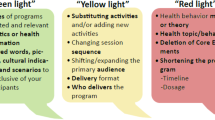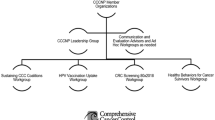Abstract
The potential for Comprehensive Cancer Control (CCC) across the nation has been realized in the last decade with 69 Coalitions developing and implementing CCC plans. Many partners at all levels—national, state, jurisdictional, tribal and communities—have contributed to this success. This article details the contribution of these partners across these various levels, with a selection of the many activities contributing to this success. Consequently the cancer burden, although still of major importance, continues to be addressed in significant ways. Although there are future challenges, CCC coalitions continue to play an important role in addressing the cancer burden.




Similar content being viewed by others
References
Given LS, Black B, Lowry G, Huang P, Kerner JF (2005) Collaborating to conquer cancer: a comprehensive approach to cancer control. Cancer Causes Control 16(suppl 1):3–14
Cole P, Rodu B (1996) Declining cancer mortality in the United States. Cancer 78:2045–2048
Wingo PA, Ries LA, Rosenberg HM, Miller DS, Edwards BK (1998) Cancer incidence and mortality, 1973–1995: a report card for the U.S. Cancer 82:1197–1207
Sutherland JE, Persky VW, Brody JA (1990) Proportionate mortality trends: 1950 through 1986. JAMA 264:3178–3184
Goodman RM, Steckler A, Alciati MH (1997) A process evaluation of the National Cancer Institute’s Data-based Intervention Research Program. Health Educ Res 12(2):181–197
Abed J, Reilley B, Butler MO et al (2000) Developing a framework for comprehensive cancer prevention and control in the United States: an initiative of the Centers for Disease Control and Prevention. Public Health Manag Pract 6:67–78
La Porta M, Hagood H, Kornfeld J, Treiman K (2007) Partnership as a means for reaching special populations: Evaluating the NCI’s CIS Partnership Program. J Cancer Educ 22(Suppl):S35–S40
cancer.org [Internet]. Atlanta (GA): American Cancer Society, Inc.; [cited 2010 Jul 2]. Available from: http://www.cancer.org
Edwards BK, Ward E, Kohler BA et al (2010) Annual report to the nation on the status of cancer, 1975–2006, featuring colorectal cancer trends and impact of interventions (risk factors, screening, and treatment) to reduce future rates. Cancer 116:544–573
Hayat MJ, Howlader N, Reichman ME, Edwards BK (2007) Cancer statistics, trends, and multiple primary cancer analyses from the Surveillance, Epidemiology, and End Results (SEER) Program. The Oncologist 12:20–37
Surveillance, Epidemiology, and End Results (SEER) Program (www.seer.cancer.gov) SEER*Stat Database: Incidence—SEER 17 Regs Research Data + Hurricane Katrina Impacted Louisiana Cases, Nov 2009 Sub (1973–2007 varying), National Cancer Institute, DCCPS, Surveillance Research Program, Cancer Statistics Branch, released April 2010, based on the November 2009 submission
Major A, Stewart SL (2009) Celebrating 10 years of the national comprehensive cancer control program, 1998 to 2008. Prev Chronic Dis 6(4). http://www.cdc.gov/pcd/issues/2009/oct/09 0072htm. Accessed 2010 Jul 2
Association of State and Territorial Directors of Health Promotion and Public Health Education, and Centers for Disease Control and Prevention. Policy and Environmental Change: New Directions for Public Health, Executive Summary [Internet]. Santa Cruz (CA): ToucanEd; 2001 [cited 2010 Jul 2]. Available from: http://www.cdc.gov/dhdsp/roadmap/docs/healthpolicyeExecSummary_ac.pdf
National Vital Statistics System public use data file. Hyattsville (MD): Centers for Disease Control and Prevention/National Center for Health Statistics; [cited 2010 Sep 15]. Available through State Cancer Profiles at: http://statecancerprofiles.cancer.gov/index.html
Acknowledgments
The authors would like to thank the multitude of organizations and volunteers across the states, tribes and territories that have made cancer control a priority in their community. It is truly through their dedication that comprehensive cancer control has become a reality.
Author information
Authors and Affiliations
Corresponding author
Additional information
The findings and conclusions in this report are those of the authors and do not necessarily represent the official position of the Centers for Disease Control and Prevention or the National Cancer Institute.
Rights and permissions
About this article
Cite this article
Rochester, P.W., Townsend, J.S., Given, L. et al. Comprehensive cancer control: progress and accomplishments. Cancer Causes Control 21, 1967–1977 (2010). https://doi.org/10.1007/s10552-010-9657-8
Received:
Accepted:
Published:
Issue Date:
DOI: https://doi.org/10.1007/s10552-010-9657-8




